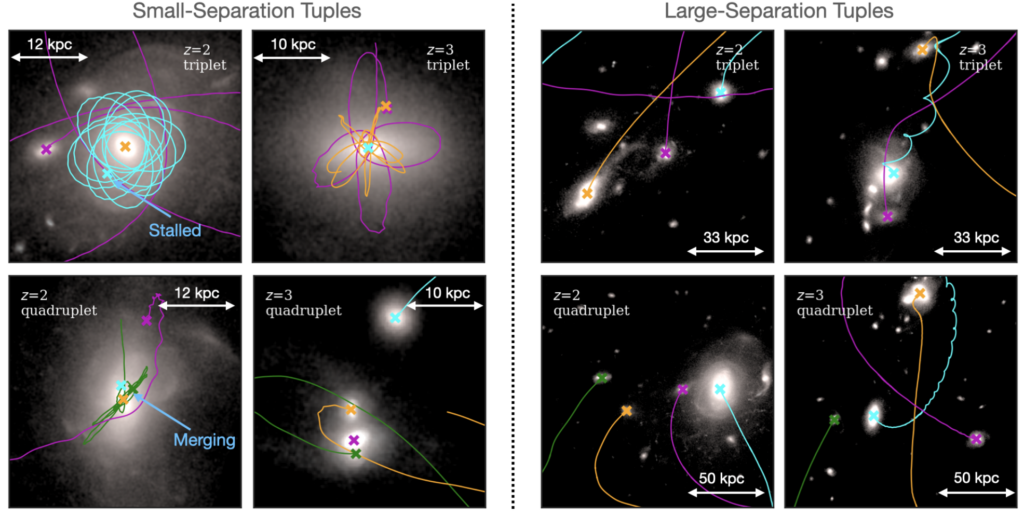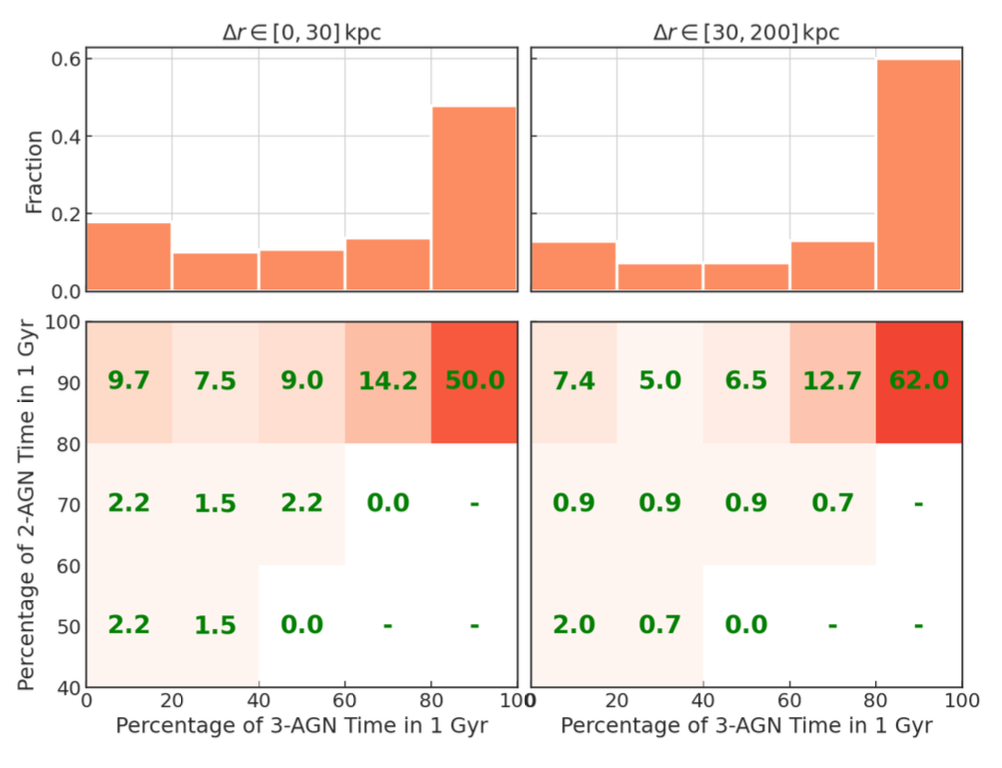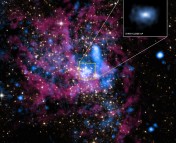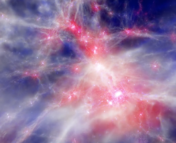Title: Triple and Quadruple Black Holes in the ASTRID Simulation at z∼2
Authors: Calvin Hoffman, Nianyi Chen, Tiziana Di Matteo, Yueying Ni, Simeon Bird, Rupert Croft, Abraham Loeb
First Author’s Institution: Carnegie Mellon University, Pittsburgh, USA
Status: Preprint available on arXiv
Supermassive black holes (SMBHs) reside at the centers of galaxies and play a crucial role in the evolution of galaxies. These central black holes possess immense energy, generating powerful winds and jets that make them appear more luminous compared to the rest of the galaxy. Such an active black hole is known as an active galactic nucleus (AGN). During a merger of two galaxies, each containing an SMBH, a binary system of SMBHs can form. If ambient gas is drawn towards the black holes during this process, it triggers the AGN activity, resulting in the binary being observable as a dual AGN. In rare cases, additional galaxies, along with their SMBHs, can also merge into the site, giving rise to a multiple-body black hole system. If all the black holes are simultaneously accreting matter, they form a multiple-AGN system. These multiple-AGN systems are believed to produce some of the most massive SMBHs known in the Universe. In mergers involving more than two galaxies, there is a continuous increase in gas supply, facilitating rapid accretion onto the massive black hole. As a result, these black holes attain tremendous masses, typically exceeding solar masses, transforming into massive SMBHs with masses around
solar masses.
However, the study of multiple AGNs poses significant challenges both theoretically and observationally due to their rarity. While previous research has primarily focused on studying interactions among massive black hole (MBH) triplets or multiplets at the parsec (pc) scale, this current paper delves into the interactions of black holes on a much larger scale, spanning hundreds of kiloparsecs (kpc), involving multiple galaxies. The authors aim to address several important questions, including the fraction of MBH systems at the hundred-kpc scale that can evolve into close-triplet systems and how many of these systems have the potential to power multiple AGNs. To tackle these inquiries, the authors utilize a cosmological simulation known as ASTRID, and they specifically select triple and quadruple systems from the simulation for their detailed analysis.
Selecting the triple and quadruple black holes
ASTRID is a cosmological hydrodynamical simulation that provides detailed BH evolution and allows for a thorough analysis of the black hole (BH) orbital trajectories. Given that triple AGN systems have been observed at a cosmological redshift of z ~ 2, the authors specifically focus on the redshift range of z = 2-3 within the simulation. They classify a BH tuple system as one where all MBHs exceed solar masses and possess a pairwise separation of less than 200 kpc.
The authors find that approximately 4% of all MBH above solar mass are involved in an MBH tuple. Figure 1 showcases an example of an MBH tuple, highlighting two distinct pairwise separations at redshifts of z = 2 and z = 3. BHs with small separations are typically found in the vicinity of galaxy mergers, whereas BHs with larger separations are embedded within their host galaxies.
Figure 2 demonstrates a noteworthy case of a runaway BH, wherein the cyan BH’s orbit is disrupted due to its interaction with an incoming dense galaxy. As a result, this BH is ejected to the outskirts of its host galaxy, illustrating the phenomenon of BH ejection.


Can we observe them as multiple AGNs?
Not all of these tuples are observable as multiple AGNs as only a few of them would have active gas accretion. Additionally, during galaxy mergers, tidal disruptions can strip certain BHs of their gas supply, rendering them inactive. To classify a BH as active, the authors set a luminosity cutoff of erg/s.
To explore the number of active AGNs within the BH tuples derived from the simulation, the authors examine the luminosities of the BHs over a time window of 1 Gyr. Figure 3 presents the probability of a triplet system being observed as a 2 AGN or 3 AGN system during its evolution. We can notice that among all the triple MBHs, more than 90% of them can be observed as a 2 AGN system with a greater than 50 % chance for all three BHs in the triplet to be simultaneously bright for 1 Gyr. Thus, the likelihood of observing a 3-AGN system is relatively high within a 1 Gyr timeframe, although half of the triplets will be missed due to the presence of one under-luminous BH in the system.

Will the BHs in the triple/quadruple systems merge?
The evolution of MBH tuples exhibits a range of outcomes, including quick mergers between the three MBHs in some cases, while others result in runaway BHs or the stalling of an MBH pair that will never merge within the age of the universe due to the presence of a third body. Each of these paths leads to a different evolution of the BH masses and luminosity. Figure 4 illustrates the mass, luminosity, and pairwise separation evolution for six different cases of BH tuple evolution.
Panels 4(a) and 4(b) show a luminous AGN component with two stalled components and are mostly seen in systems with small pairwise mass ratios. In both cases, the infalling BHs with masses close to solar masses lead to the growth of the more massive BH, which eventually makes the infalling BHs inactive as their luminosities drop below
erg/s.
In panel 4(c) we see a scenario where two of the heaviest BHs in the triple systems merge while the third BH experiences tidal stripping and becomes stalled. Notice that the merging massive BHs have similar masses that lead them to a merger, leaving the smaller BH in a wandering state, separated from the merging pair.
Panels 4 (d) and (f) showcase consecutive mergers in a triple and quadruple system respectively. These mergers are between MBHs of similar masses and similar luminosities.
Three-body interactions between MBHs can also lead to the ejection of the least massive BH in the system. In Panel 4 (e), we see a very interesting scenario where during a quadruple interaction, frequent orbital disruptions lead to the two least massive BHs being separated from the galaxy center.

All of these cases are correlated with the pairwise mass ratios in BH tuples. The authors find that quick, consecutive mergers are found in equal-mass BH systems with pairwise mass ratios (q) above 0.1. On the other hand, a larger contrast in BH masses leads to tidal disruptions and the stalling of BH orbits.
The study also sheds light on the formation of the most massive SMBHs, also known as Ultra-Massive Black Holes. The authors find that MBHs in triplet systems can undergo a phase of rapid mass growth as seen in some of the examples in Figure 4. Three SMBHs of mass solar masses could merge and result in the formation of a very massive
solar mass BH through rapid accretion and mass growth. Among the BHs with mass greater than
solar masses, half of them have gone through a triple MBH phase in the simulation.
The results of today’s paper emphasize the importance of studying MBH tuples and the outcomes of their interactions. Multiple-BH systems are a pathway to produce runaway BHs as well as the heaviest SMBHs in our universe. It is possible to associate the runaway BHs to observations of flares in tidal disruption events and could be detected at a rate of a few events per year by the Vera C. Rubin observatory. Future gravitational wave detector LISA would be able to detect gravitational waves coming from binary MBH mergers influenced by triple interactions. With various observational methods such as multiple AGNs, gravitational waves, and other electromagnetic observations, the future looks promising for the study of these systems.
Astrobite edited by Konstantin Gerbig
Featured image credit: Adapted from today’s paper





The abbreviation “NSC” (“nuclear star cluster”) is used without being defined in this nice summary.
Thanks for pointing it out!